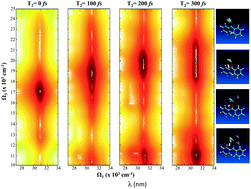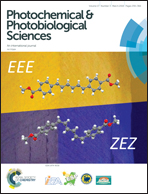The effect of solvent relaxation in the ultrafast time-resolved spectroscopy of solvated benzophenone†
Abstract
Benzophenone (BP) despite its relatively simple molecular structure is a paradigmatic sensitizer, featuring both photocatalytic and photobiological effects due to its rather complex photophysical properties. In this contribution we report an original theoretical approach to model realistic, ultra-fast spectroscopy data, which requires describing intra- and intermolecular energy and structural relaxation. In particular we explicitly simulate time-resolved pump–probe spectra using a combination of state-of-the art hybrid quantum mechanics/molecular mechanics dynamics to treat relaxation and vibrational effects. The comparison with experimental transient absorption data demonstrates the efficiency and accuracy of our approach. Furthermore the explicit inclusion of the solvent, water for simulation and methanol for experiment, allows us, despite the inherent different behavior of the two, to underline the role played by the H-bonding relaxation in the first hundreds of femtoseconds after optical excitation. Finally we predict for the first time the two-dimensional electronic spectrum (2DES) of BP taking into account the vibrational effects and hence modelling partially symmetric and asymmetric ultrafast broadening.

- This article is part of the themed collection: 28th International Conference on Photochemistry (ICP 2017)


 Please wait while we load your content...
Please wait while we load your content...